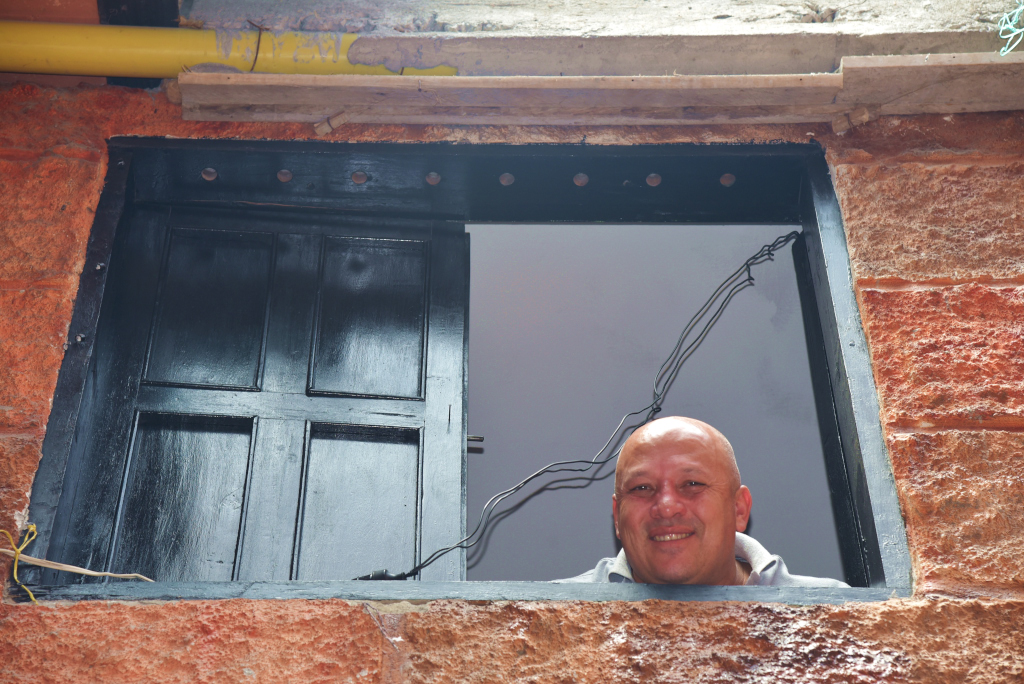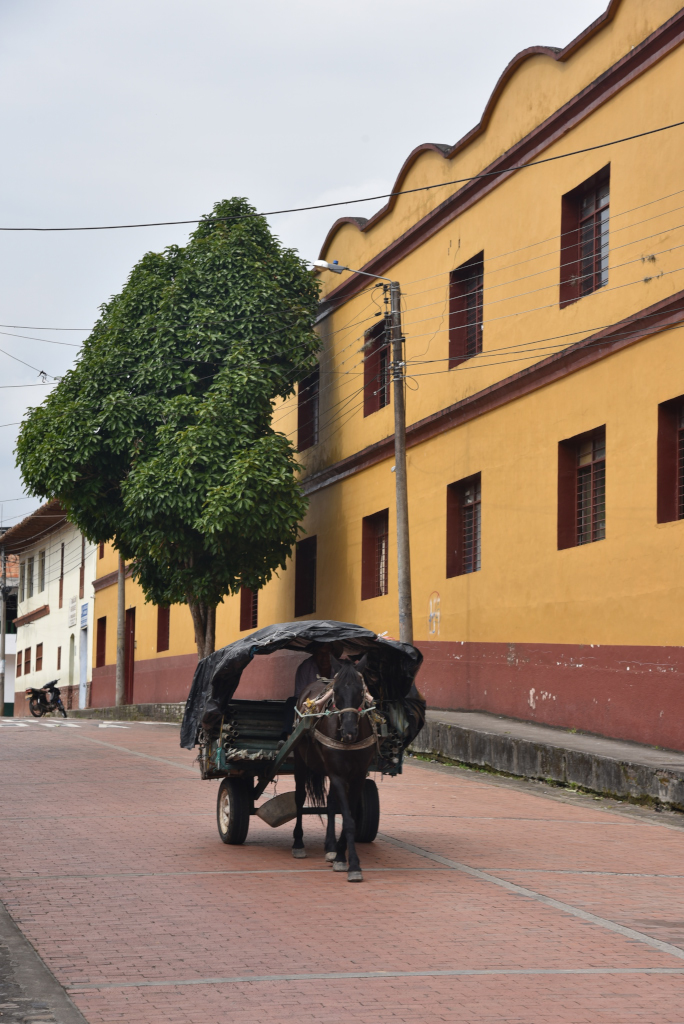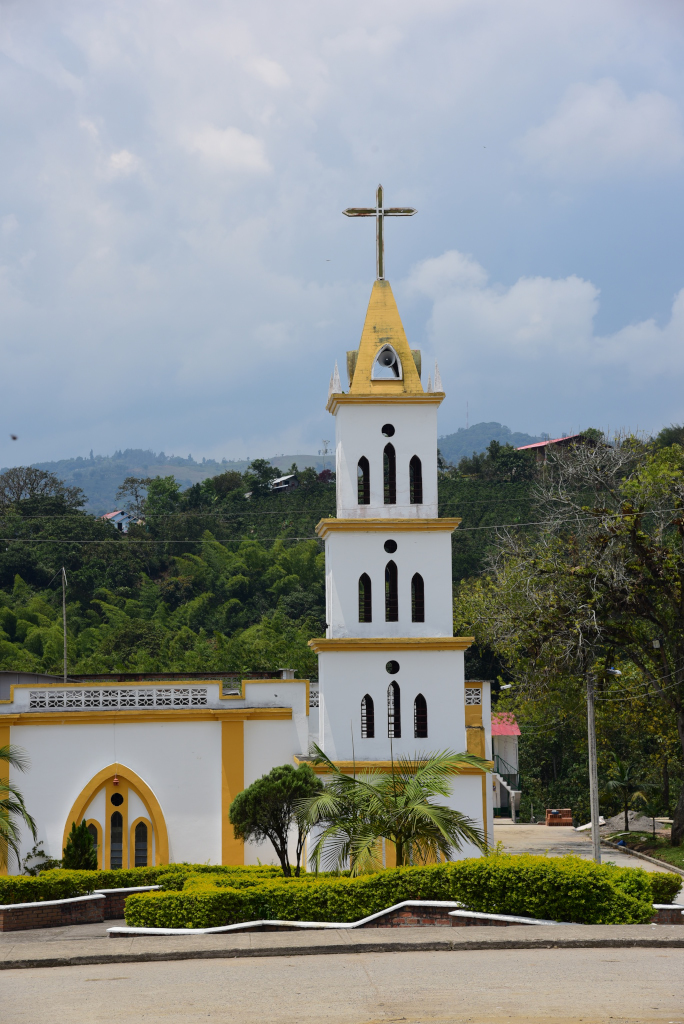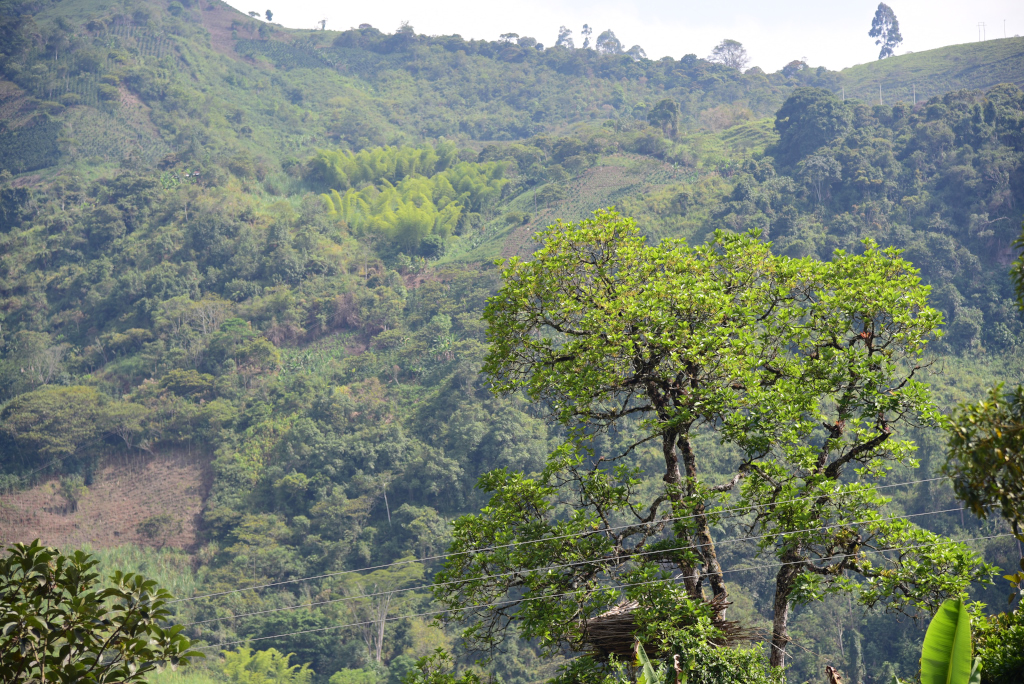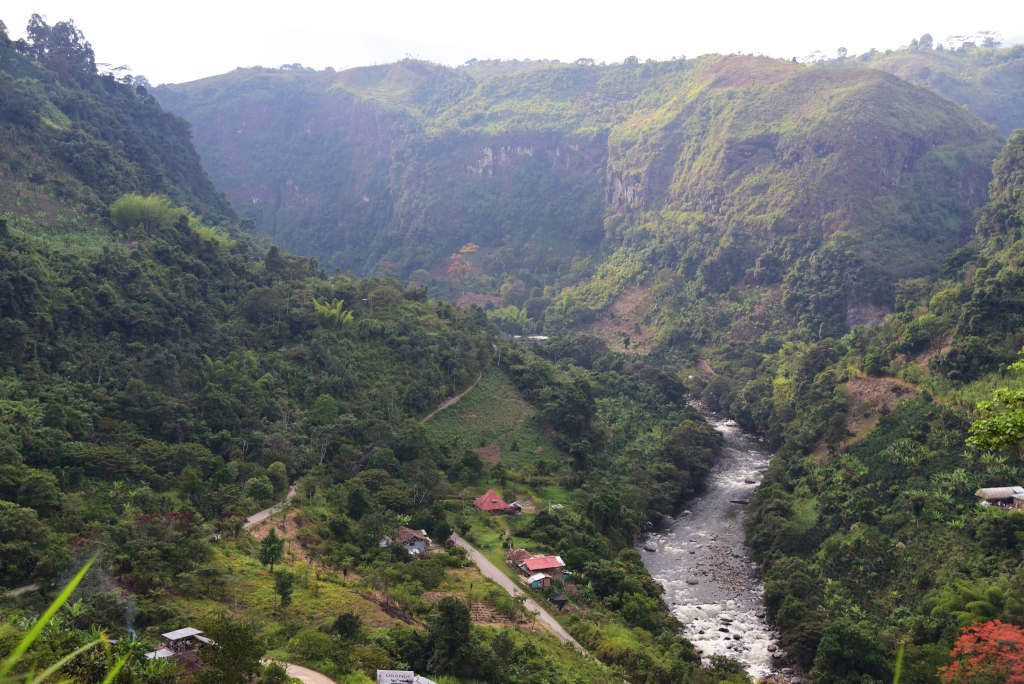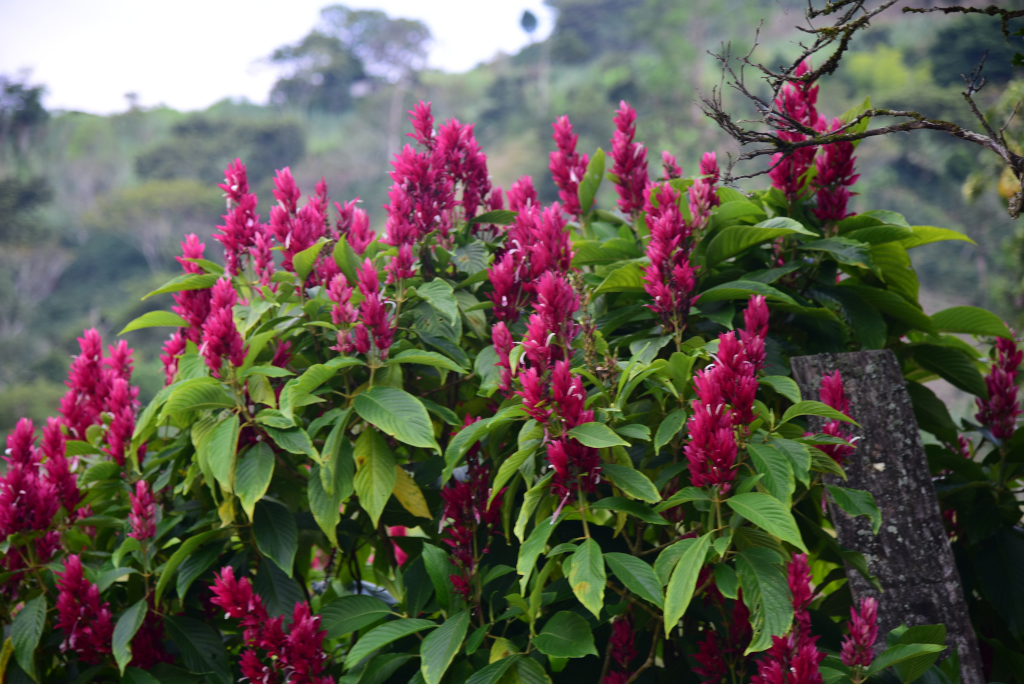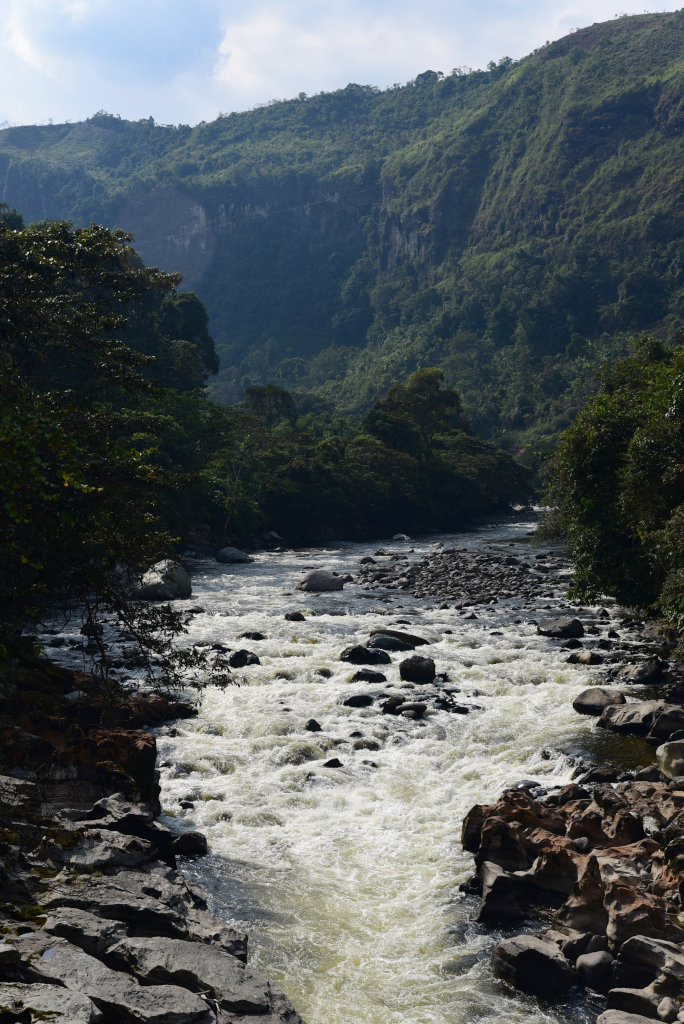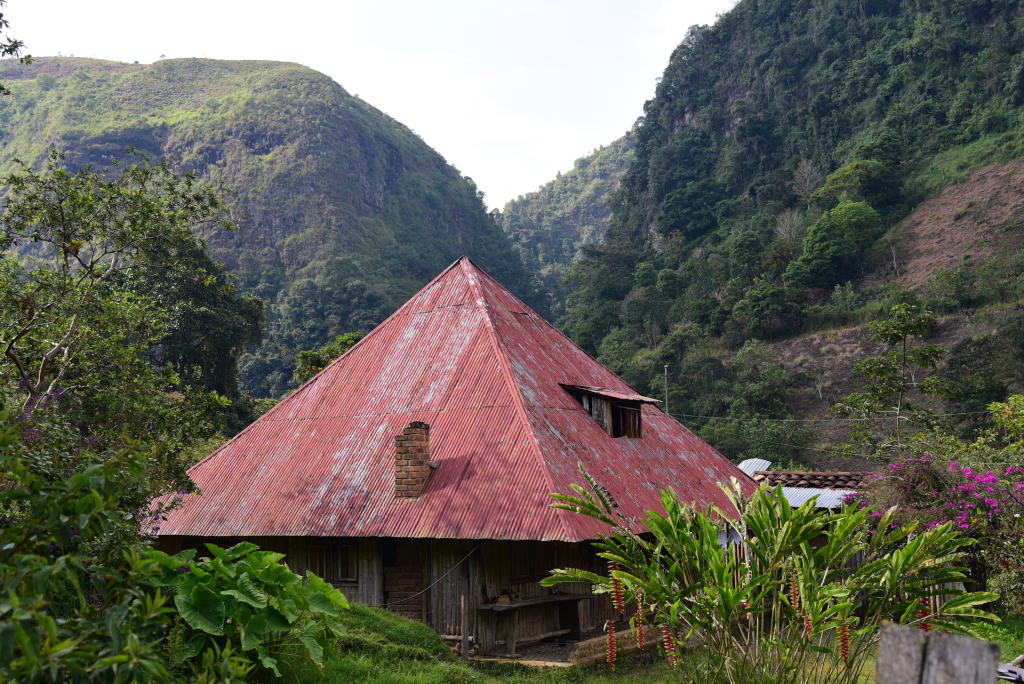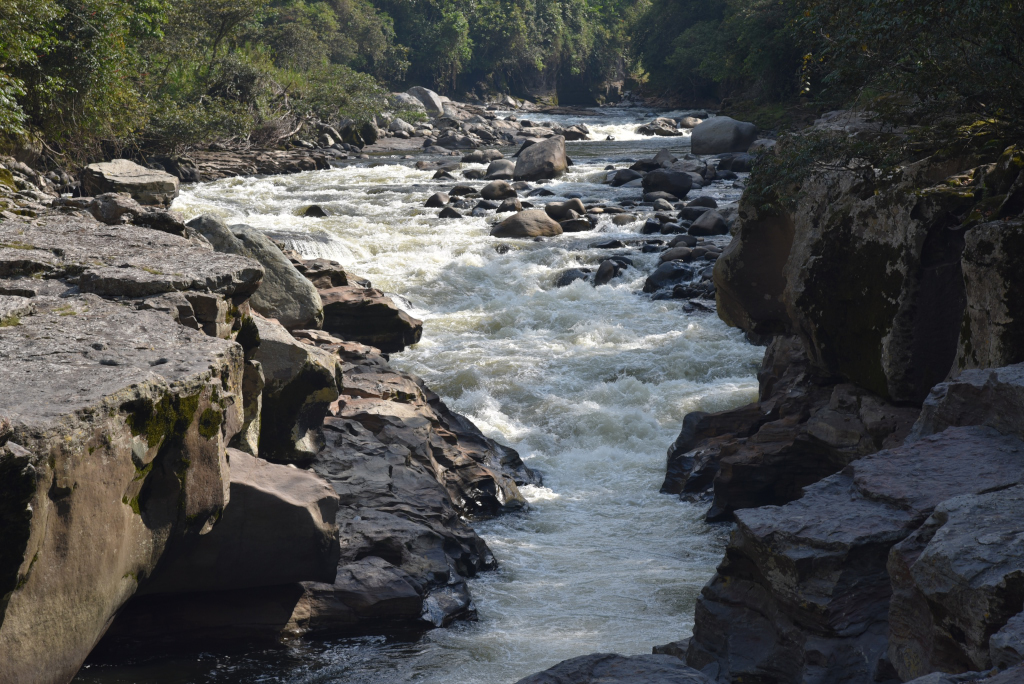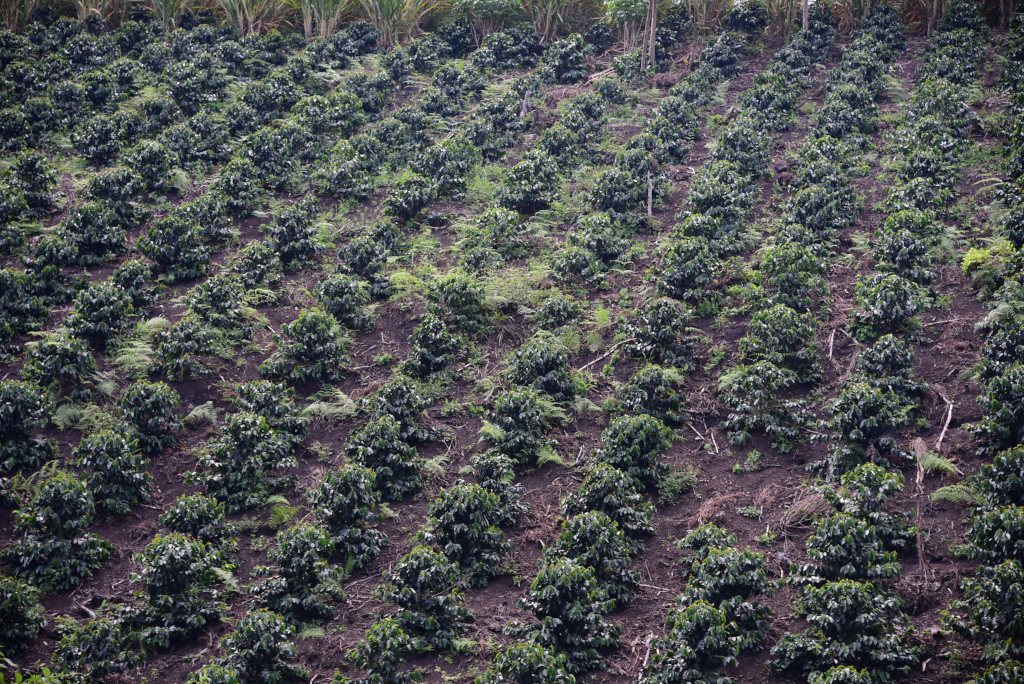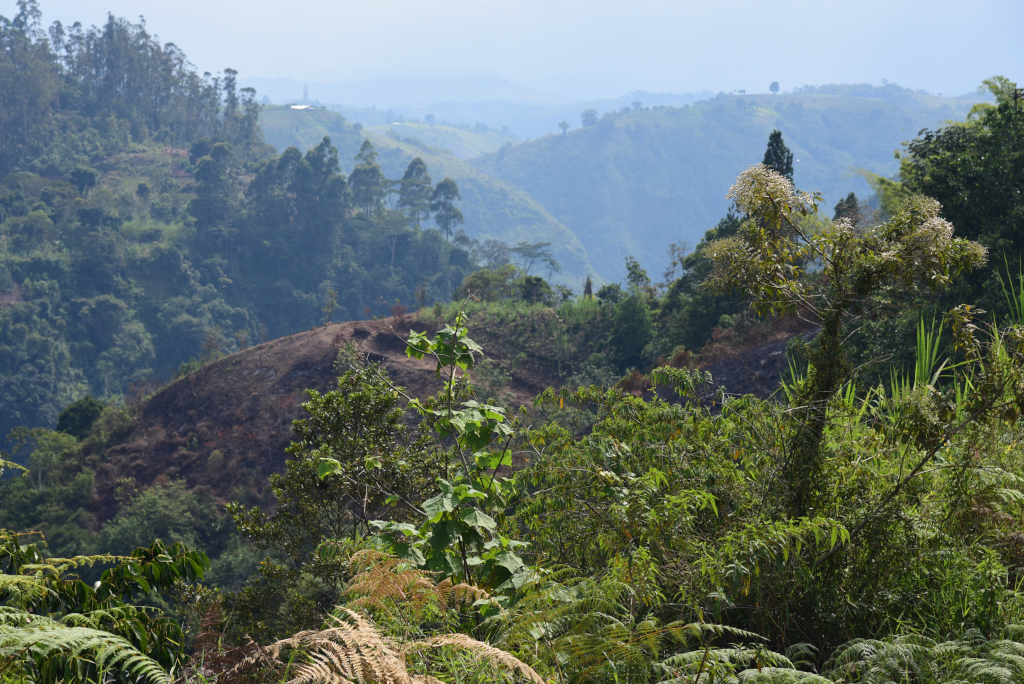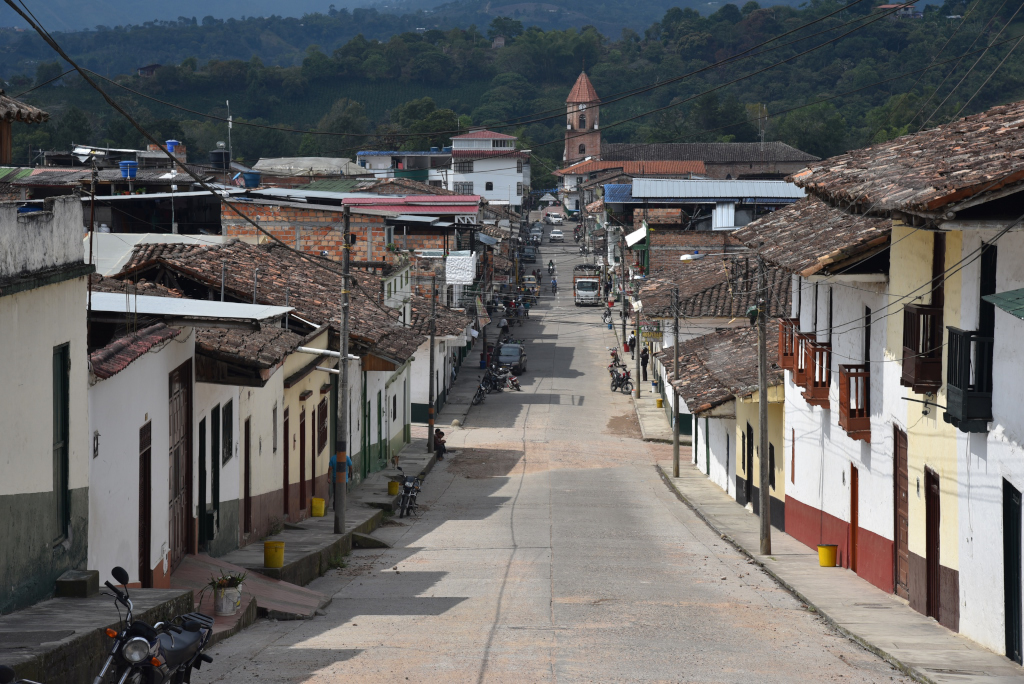March 20, 2018
I am decided: I will spend the day visiting some of the attractions on the outskirts of town, and then tomorrow migrate to one of the higher caliber housing options in the countryside. The noise levels both from the street as well as inside the hotel are really beyond what I want to be tolerating, the electricity is out (not the fault of the hotel, but it doesn’t serve to make the place more inviting), the wifi is out (as a result of lack of electricity), and downstairs, the staff person hasn’t appeared to make breakfast. Individually, I could forgive some of these issues, but I get the impression of a hotel that has seen better days.
On the street, things are not looking much better. By 9 am, the sun should be shining on San Agustín and the folks filling the street, but the light is dull grey, the town looks drab, there are few people on the street, and even worse, most businesses are closed. One more reason to not be here.
The Tienda de Café Chapará is closed, and so I migrate up to Hippy Row to see if any other coffee shop may be open, ambling past the drab adobe structures bereft of life. On the western side of town, closest to the archaeological park is the Bici Cafe, which attracts more of an alternative crowd, but does have decent coffee at the moment. The young French-Canadian woman sipping her coffee decides to make a run for it when she can’t sustain more clichés about Quebec and its residents, not that I had much intention of spending more time here myself.
The town is still ensconced in its traditions of using horses for transportation, both for riding and pulling carts. Carrera 13 seems to be a regular corridor for horse-based traffic, as evidenced from my perch next to the Hostal Bambu. The town features little of the graffiti and murals found in so many Colombian towns, although perhaps the reason is due to the fact that the town is so small. On the other hand, it would seem the substantial hippie presence should be a good reason to provide that kind of background decor. San Agustín may be surrounded by green space, but it is certainly not internally bedecked in green.
Even though there are few people on the street, I feel self-conscious pulling out a camera. I react defensively when a physical education teacher asks me what my camera is worth, since that is usually a red flag. But he seems to mean well, not that he should remotely be in the marketplace for a full frame camera.
What to do, what to do. I have little desire to shoot photos of this very unspectacular town. On the Parque Simón Bolívar, there is some sort of free hair cutting even going on, which reminds me that I need to get my hair cut, although it would seem embarrassing at the moment to be taking seats away from the more needy, although it may just be a publicity stunt. The police officers in attendance are wearing special outfits, somewhat different green uniforms but notably, orange braiding across the right side of the chest and Stetson-styled hats with upturned sides and four indents on the crown.
The plaza is visually somewhat interesting, with copies of the statues found at the San Agustín historical site, although they hardly synchronize with the somewhat pedestrian architecture framing the plaza as well as the lethargic groups of largely elderly men gathered in the park.
Watching the garbage men at work hardly constitutes the most engaging touristic activity, but it is a reminder of who some of the hardest working people in this country are, typically running after the garbage truck while throwing garbage into the back, in their full-body outfit, and often in the blazing heat.
Another round of misguided frivolity: lecturing the manager of a bakery about the merits of moving to Canada and making loads of money prior to returning to Colombia years later in all her glory, then backtracking with a series of caveats as to what may go wrong. But she is interested, as she should be: there is are substantial communities of Latin people in Canada, they can integrate relative easily (other than considerations of climate), and particularly with some specialization real opportunities for professional and financial advancement exist.
Below, another wide square and the submerged-looking Iglesia de Lourdes framed against the lush forest rising into the mountains above. The adjacent market is shutting down for the day, a few vendors calling to me, but stocking up with produce prior to embarking on a long hike would probably not be appropriate.
The owner of my hotel enumerates the attractions around the Estrecho del Magdalena that I could visit, and then I am off to the corner of Carrera 15 and Calle 5, where the collective bus to Obando apparently leaves, but no, no, the motorcycle taxi drivers waiting at the intersection assure me, there is no such service available, at least not during the week, and I can only go by means of their service. COP $40,000 will allow me to visit each of the sites courtesy of their service.
It wouldn’t bother me if they were telling the truth and I had to accept spending more money than I had intended, however, I have a very strong suspicion that I am being lied to, and that for me is not a good thing, as it casts a seriously negative pall on the experience of the place. At a nearby almacen, the owner assures me that there is in fact a colectivo that is intended to leave from the intersection at 12:30. I return to a nearby tienda, consuming a bag of merengues while watching the uniformed school children filing in for their small rituals, fascinating to see how they mimic adults in their behavior.
The pickup truck arrives, but is heavily loaded with merchandise and people. All the seats inside as well as at the back of the cramped vehicle have been taken, and the only way of taking the vehicle is to hang off the back. Well, you wanted that Third World travel experience – this is it! Another vehicle pulls in, very empty, but leaving later. I need to leave now – I have spent too much time dawdling this morning, and need to go now!
San Agustín is small enough for little traffic to obstruct our progress, and a few blocks from the centre, we are already rising into the countryside above the town, the narrow paved road snaking through the fenced fields, sprawling country houses, pastureland and forest, which threatens to engulf everything around us. The road weaves higher and higher, with the elevation spectacular vistas of the verdant mountainsides and colourful vegetation unfolding.
Beyond the spectacular array of flowering bushes and trees, I am struck by the amount of guadua, a species of giant bamboo prevalent in Colombia, as well as tree ferns, which are hallmarks of the exotic for me. As the road weaves higher and higher, then drops again, the vistas change continuously. I would love to walk this entire route back, but as we proceed further and further into the mountains, it seems unrealistic. I am not even sure if there is any public transport service returning to San Agustín – at best, I could walk some of the way, then take a vehicle back. Then I am also not sure how safe the area is for a lone foreigner to be walking by himself with an expensive camera dangling from his neck …
The beaming woman hanging next to me off the back of the vehicle tells me that the final destination, Obando, actually has a museum and archaeological park, and that I shouldn’t miss that either. I am decided then: I will go all the way to Obando and see how things unfold. The views of the Estrecho del Magdalena reveal themselves before us as we now weave downhill into the small verdant canyon where the mighty river that traverses the western part of the country and mouths into a giant delta spanning much of the Caribbean region originates. And we rise again, weaving higher and higher up the mountainside to the tiny bucolic burg of Obando.
I am pointed to the archaeological park which dominates the central plaza of the small town. Little is known of the culture, other than that it thrived in the region in the first half of the first millennium before vanishing into the mists of time. The accidental discovery of the burial sites where largely domestic utensils were discovered was quickly pillaged and the bulk of valuable items distributed to brokers and on through the chain. The small unlit museum elaborates at length at the damage of such activity to the country’s patrimony. This is of course a universal problem, and the allure of money for locals is overwhelming, just as is the greed and lack of ethics of brokers and collectors.
The site consists of a series of pits with once brightly painted steep yellow staircases leading down towards the tiny caverns, in which little is visible without a light, not that I am particularly motivated to risk my wellbeing to see a few remaining potshards. The building housing the reception also features an extensive shop with local arts and crafts, which are largely not shabby, but I have no intention of buying anything unless it is truly memorable.
Another very long and largely irrelevant conversation at a tienda in the corner regarding the economy of coffee with the owners, my fundamental optimism about the country’s most valuable legal agricultural product being China’s emerging demand for coffee. Even though the price has been dropping in the recent past, I can’t see the future for coffee not being bright.
And off on the trek towards the Estrecho del Magdalena, the immediate countryside around Obando already riveting, with the grids of small coffee plants on display at steep angles, the thick bristling stocks of sugar cane, small groves of tropical fruit such as lulo, the lustrous groves of guadua bamboo, eruptions of tree fern, steep mountainsides rearing majestically before me. And as everywhere, copious amounts of brilliantly-coloured flowers expand in all directions. The landscape evokes a sense of serene beauty that exemplifies the Colombian countryside at its best.
At this lower elevation, the vegetation is fecund and rich in diversity, not that the country is obliterated by the needs of agriculture or pasture, as found in other parts of the country I have visited. The land use here seems much more edited, leaving much of the land still forested, vibrant, dense and wild. Visual cues are diverse and ubiquitous, ranging from the towering crowns of trees framed against a verdant hillside, the crests of the lime green guadua fanning out above me, false bird-of-paradise or heliconia, hibiscus, marmalade bush, the feathered branches of the flame tree, tibouchina, and so much more. The flame tree framed against the wall of green looks particularly spectacular, as do the rows of towering lighter green guadua.
The road winds downhill towards the Estrecho, the greenery soaring higher around me, my shirt now soaked in sweat, as the elevation is still low enough and the humidity to be very noticeable. Lower and lower, and finally I arrive at the entrance to the Estrecho del Magdalena, which is nothing more than a series of broad, shallow waterfalls leading to some quiet rock pools. Obviously, the river doesn’t originate here, but it gives people an excuse to come to a specific point and celebrate the beauty of the site, probably this one having been chosen because of the waterfalls.
There is only one other party present, staring at the slowly swirling pool and my camera when I walk by. At the entrance, an older man and his young female cohort are busy pressing oranges from his nearby finca. He insists on doing everything the long way, that is, not using an electric juice press, as he believes the more manual process releases more flavour from his oranges. I won’t argue with him: the taste of his orange juice is intense, acidic and rich, in a way that is rarely found, and certainly not in the blander, more commercially acceptable version of the juice.
So now comes the hard part: the walk back to San Agustín, or at least the nearest attraction to the Estrecho, which will be one of the archaeological sites I saw earlier on en route to Obando. It will be quite a walk, probably not realistic, although I am hoping that one of the pickup trucks heading back to San Agustín arrives sometime soon and drives me the rest of the way. If I don’t get a ride, I would arrive in town well after dark, an idea I don’t want to contemplate.
More of an immediate concern is that I am overheating, my shirt absolutely soaked, thanks to the lengthy uphill climb that offers increasingly dramatic views of the valley the Estrecho is located in. From my recollection of the trip here, this portion of the road was the most dramatic part of the road to Obando, so the camera is ever-present in my sweaty hands. In any case, the photos I take would never pay adequate tribute to the very rich colours in evidence in the dramatic landscape around me.
What seems amazing is that so few visitors are in evidence, although perhaps they come much earlier in the day, be it in Obando, at the Estrecho, or on the road back. Nor has the collective truck returned, and now the light has fallen considerably, given that the mid-afternoon clouds have passed behind some clouds, a forewarning of what may happen if no transport appears. There are innumerable motorcycles on the route, passing in both directions, and given that I see some of the same riders repeatedly, I have to conclude that at least some of them are motorcycle taxis.
Having heaved all the way up the mountain, witnessing the incredible views of the Estrecho below, a motorcycle does indeed stop and offer to take me back to town for a paltry COP $3,000 – plus any tip I may deem appropriate. The driver is most charming, and strangely enough, the return seems to cover a lot less distance than the outbound journey. Perhaps I was just so taken by the scenery on the initial trip!
We pass by the access roads to El Tablon, La Chaquira and La Pelota, three minor archaeological sites that are also located in this area, that I will have to visit on a subsequent day. The driver also points out a house where a woman apparently serves exceptional coffee, not that I need to be drinking even more coffee! Judging by the distance from these sites to San Agustín, I could just take a motorcycle taxi to the furthest location early in the day and simply walk back. And walking in such a pretty area hardly hurts …
Speaking of coffee, I can’t help but return to the Café Chapará, which turns into another extravagant and largely pointless chatter session. Fredy holds his young, curly-haired son as he talks to me, calm and measured, having come here from the capital years ago with his wife, proceeding first to Neiva, their lives far simpler now with children and in his case, a life also dedicated to teaching young children in a rural setting.
He despairs for the relative lack of direction and motivation of the children far removed from civilization, but such is the world: the people who live deep in the country have different priorities, and live far from the lofty ideals of people with far more access to the diverse stimuli of a larger world, not that I would remotely feel sorry for people living in this Garden of Eden setting – as that is how rural Colombians live.
Our conversation drifts into the subject of cryptocurrency, in particular, whether mining it would be a good proposition. I expound superficially on the subject, attach all manner of caveats, but the subject is esoteric for the literate, never mind those far removed from such a world in every sense. His wife Camila has been wandering around with the young children and now rejoins the table, taking the conversation in an entirely different direction. How is it that tourists come here to look at the stone idols from a different era but have no interest in making contact with the people who live here now?
I begin on the subject, but words fail me: how should I address this issue? I am just thankful I speak a fair amount of Spanish and can enjoy a relatively rich engagement with innumerable Colombians, even if it does involve repeating a lot of trite, clichéd ideas to the friendly, welcoming populace. She becomes more effusive, drawing upon the subject of her faith, gushing that her entire existence she can thank God for, where she used to be a drug addict, depressed, thinking about suicide, now she is exuberant, celebrating the love of God in her family, her married life, and life in general. Yes, she concedes, God is close to the Colombian people, as has always been the case, as they carry their faith close to their heart, ‘porque la gente es tan rica!’ she comes to a gushing finale.
Tripadvisor seems to be very optimistic in terms of the wide range of restaurants with high ratings that are in town, but wandering through the darkened streets, it seems very unlikely any of them will be opening soon. I could go back to the very good Middle Eastern place, but am set on trying something different. The pizza places are flogging their wares for prices that are too high for my liking – like seriously guys – in San Agustín? The young women selling the chicken-stuffed pastries self-consciously tells me that she has run out just when I arrive again. The crowd of adherents gathering around her cart bursts out laughing when I announce loudly that’s what happens when I leave her alone for too long.
There is nowhere else left: except the El Fogon. I am not into traditional Colombian food at the best of times, but even less into throwing money at bad hippie food. So an all-out meat and starch extravaganza ensues, attempting to stuff as much of the reheated roast pork and assorted yucca, patacon, rice and potato into my mouth while watching the adults speak in hushed tones and young boy cavorting wildly in a desperate attempt to garner attention, which takes me back to my own frustrated moments of early childhood.
The electricity is back on in my room, but it’s now back to sitting my tired body on the sagging mattress in the overheated room. There isn’t even a ventilator … No thanks!



